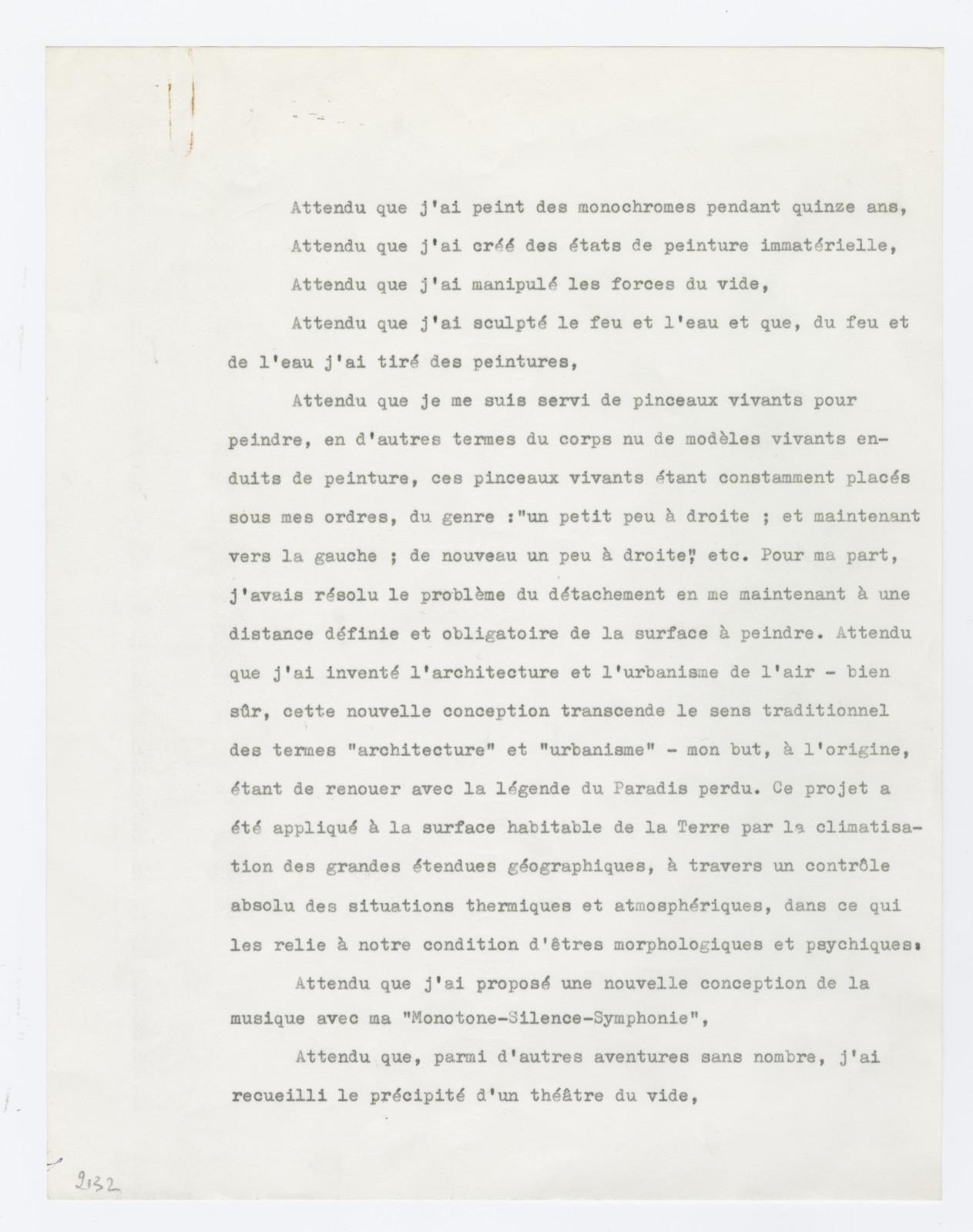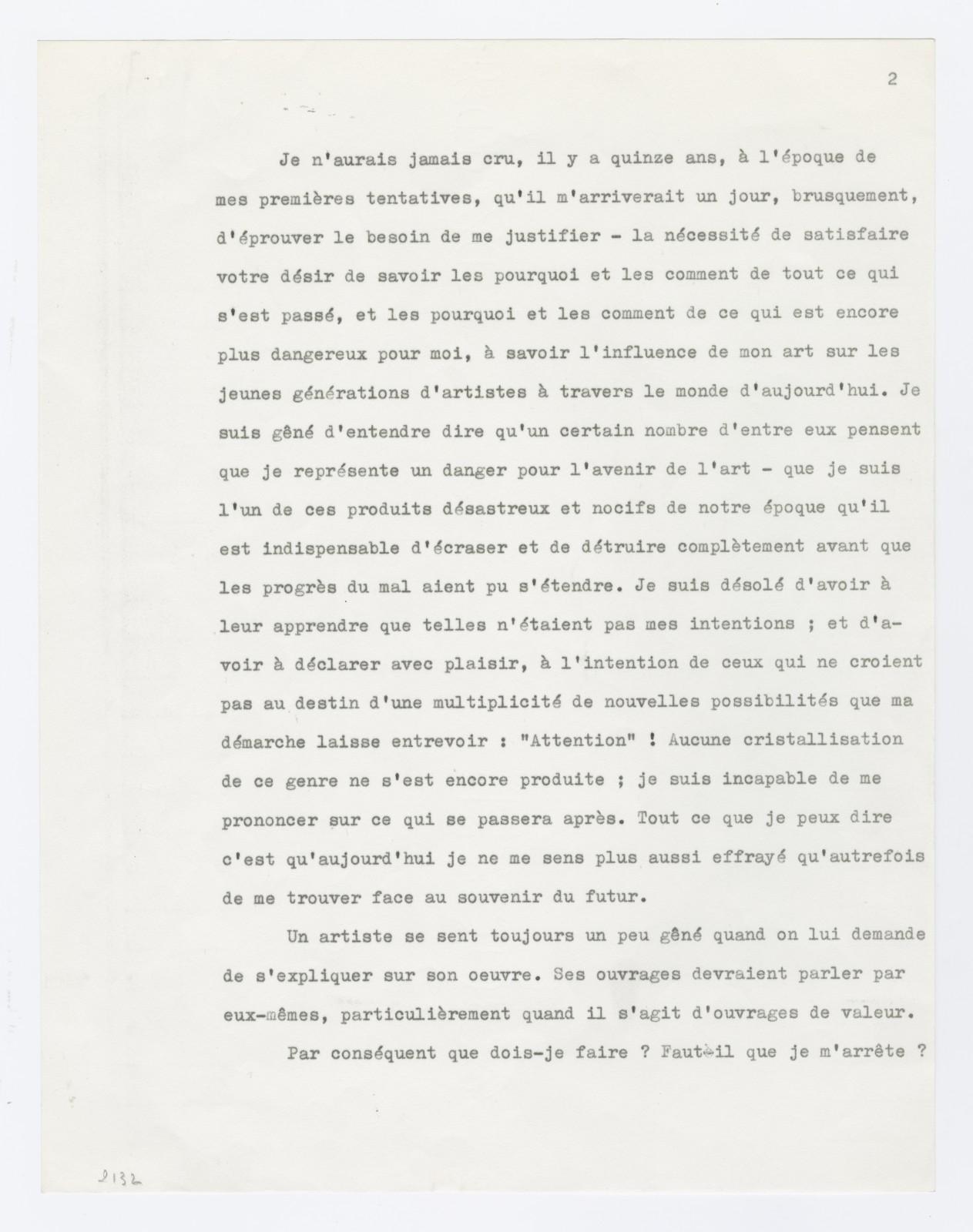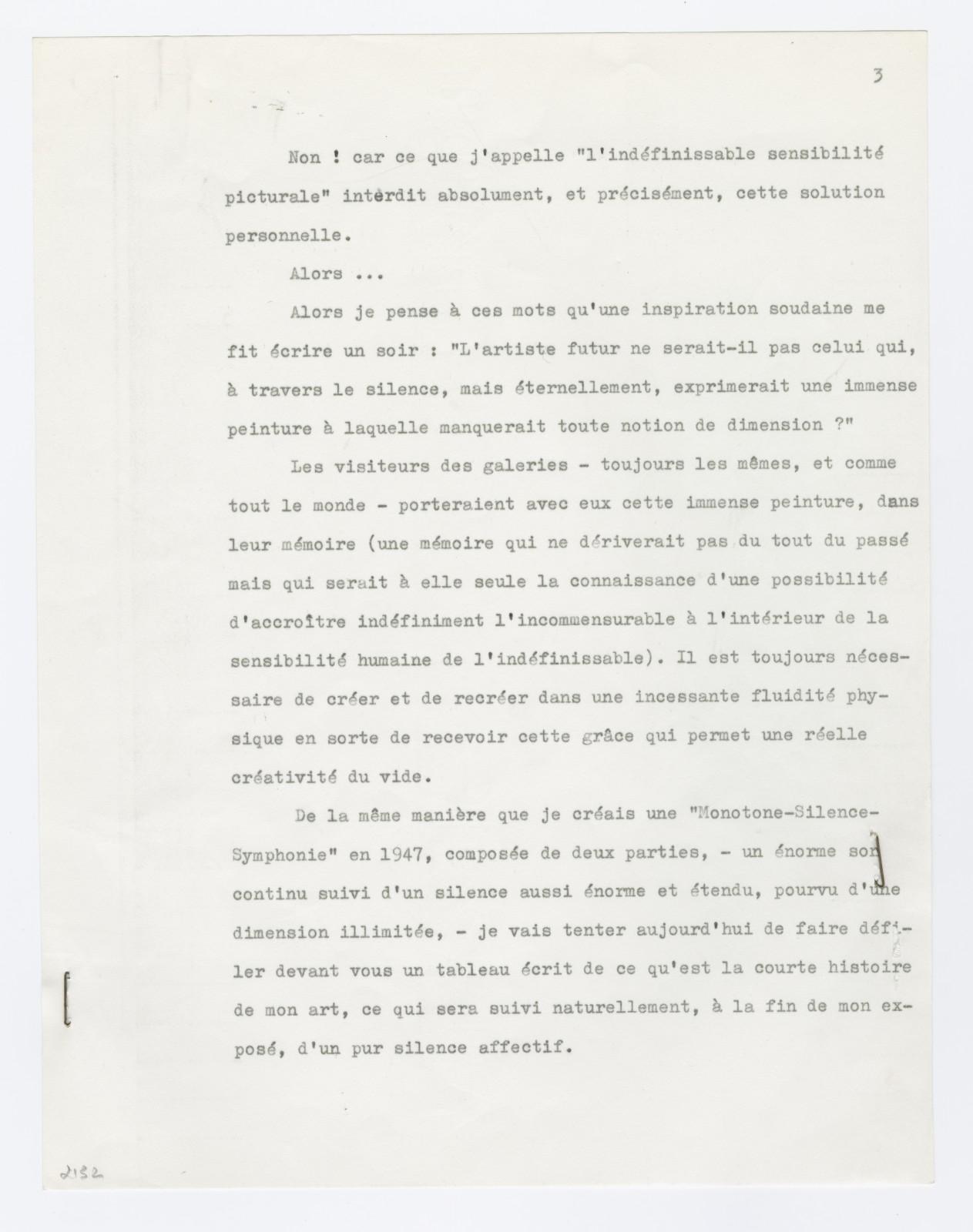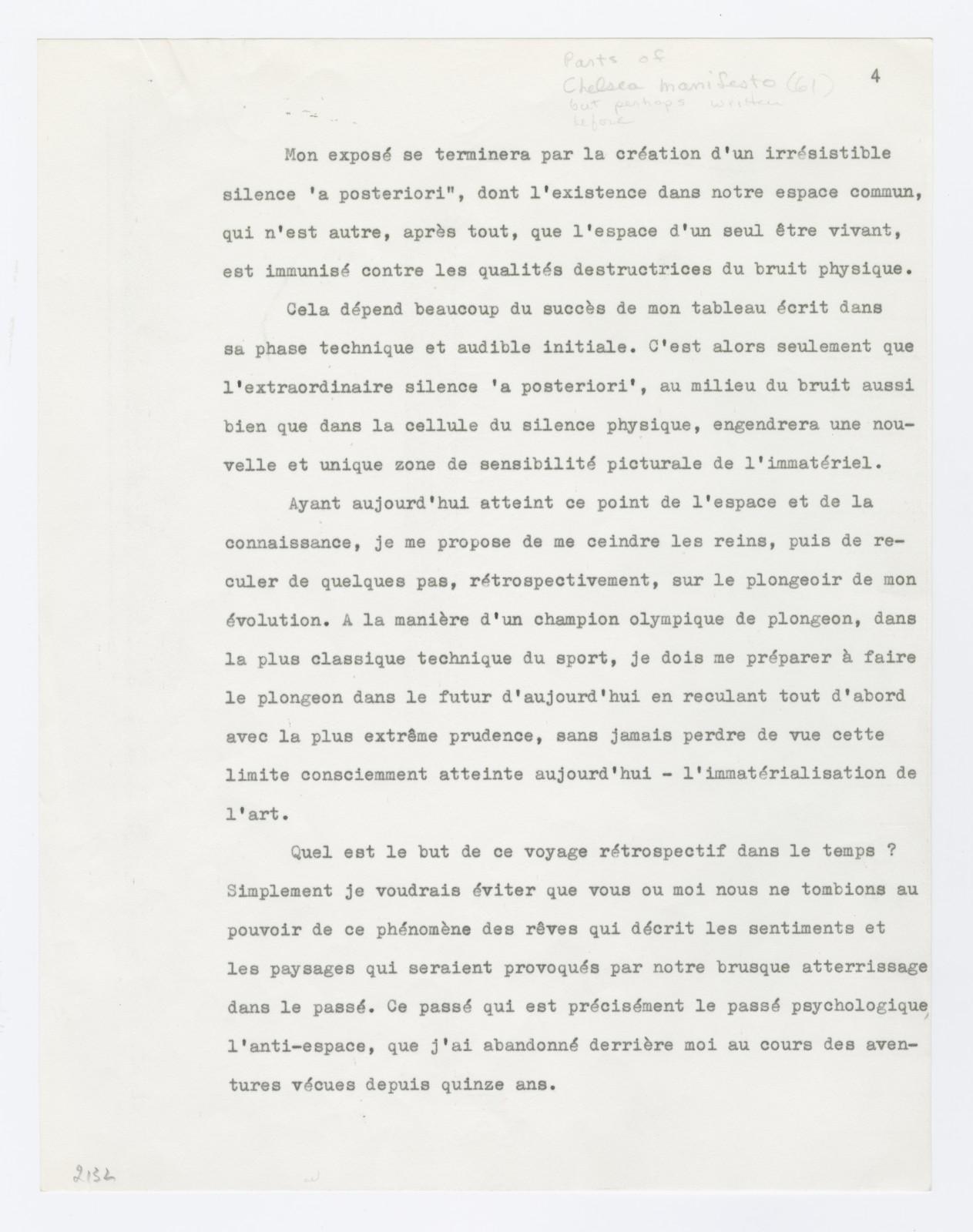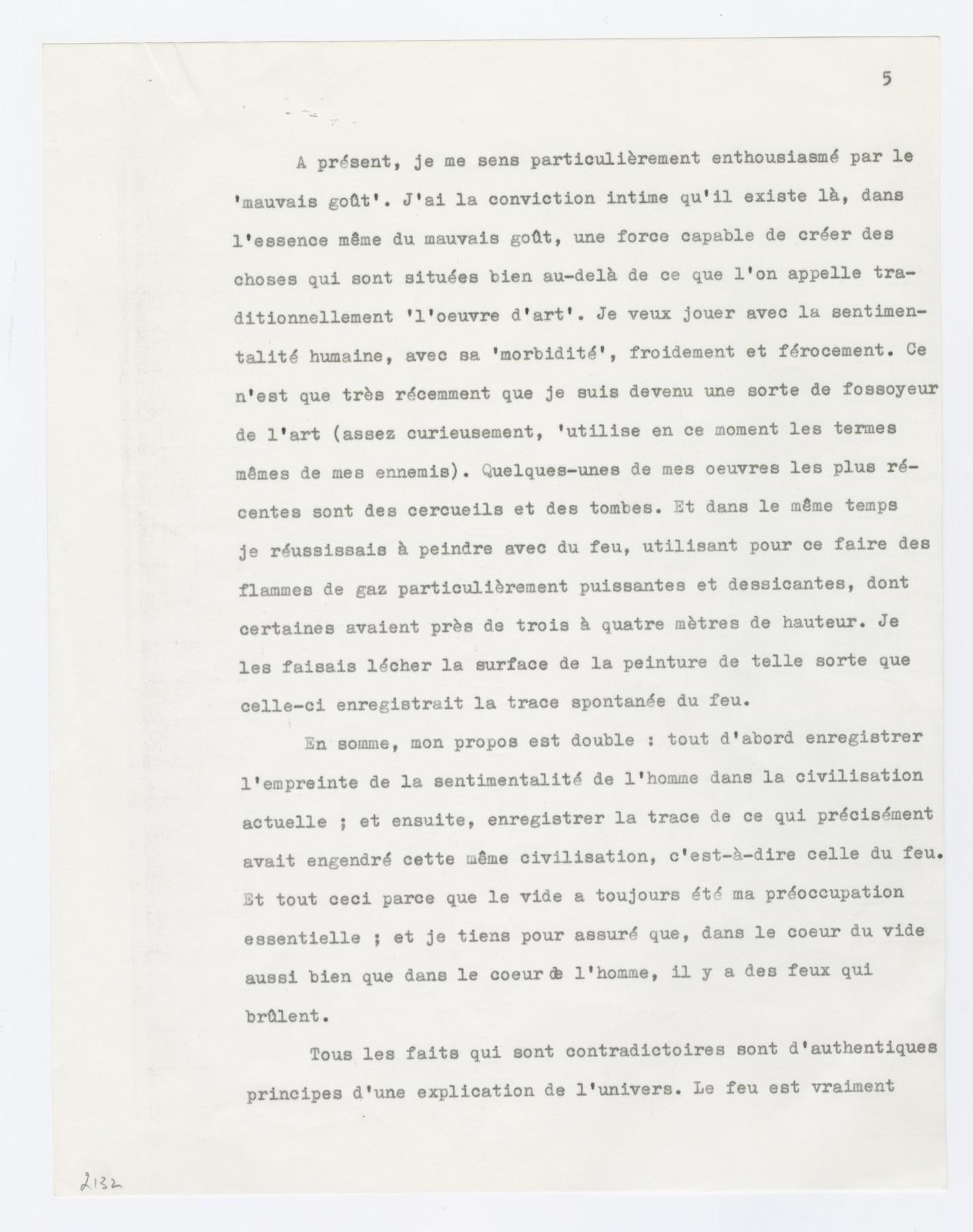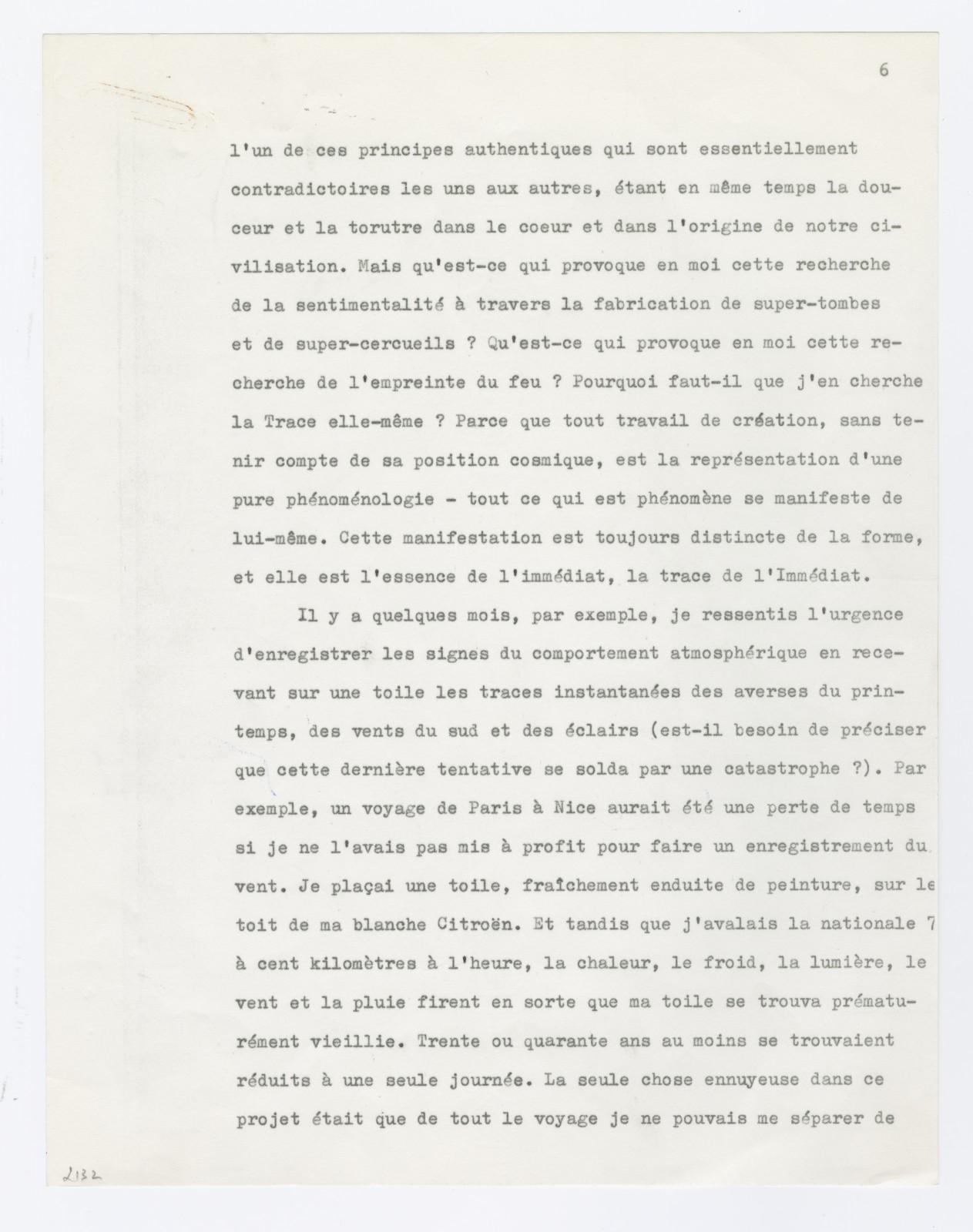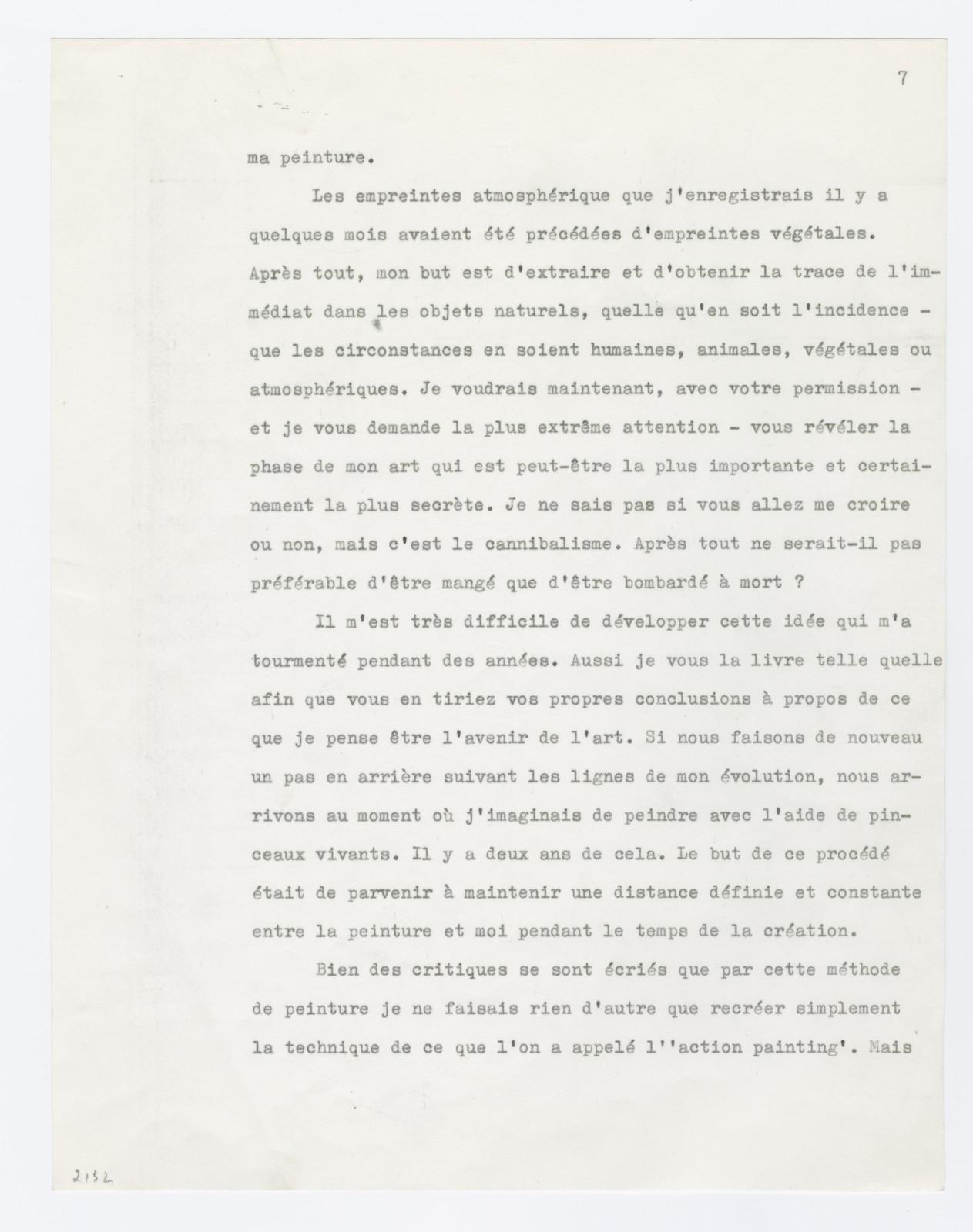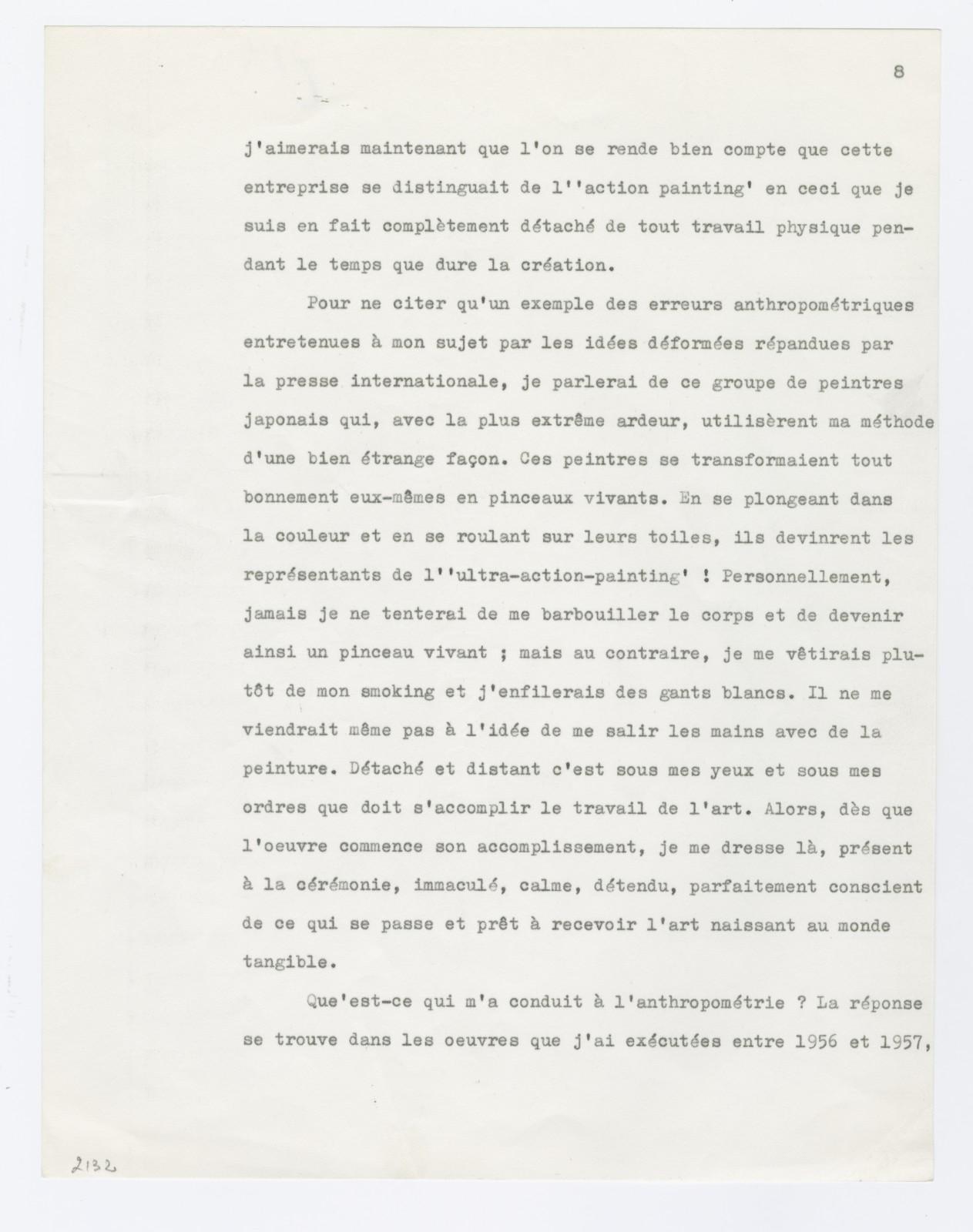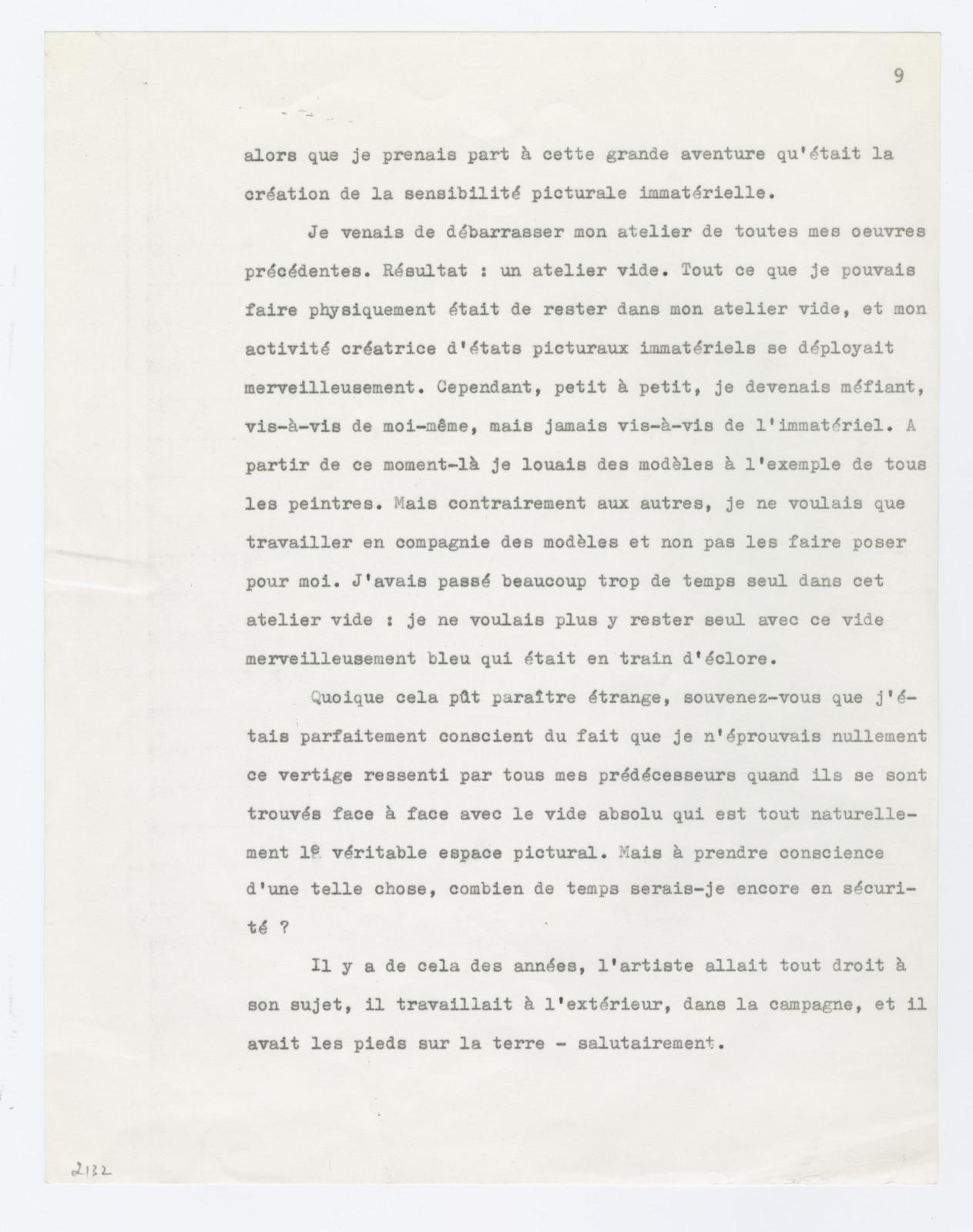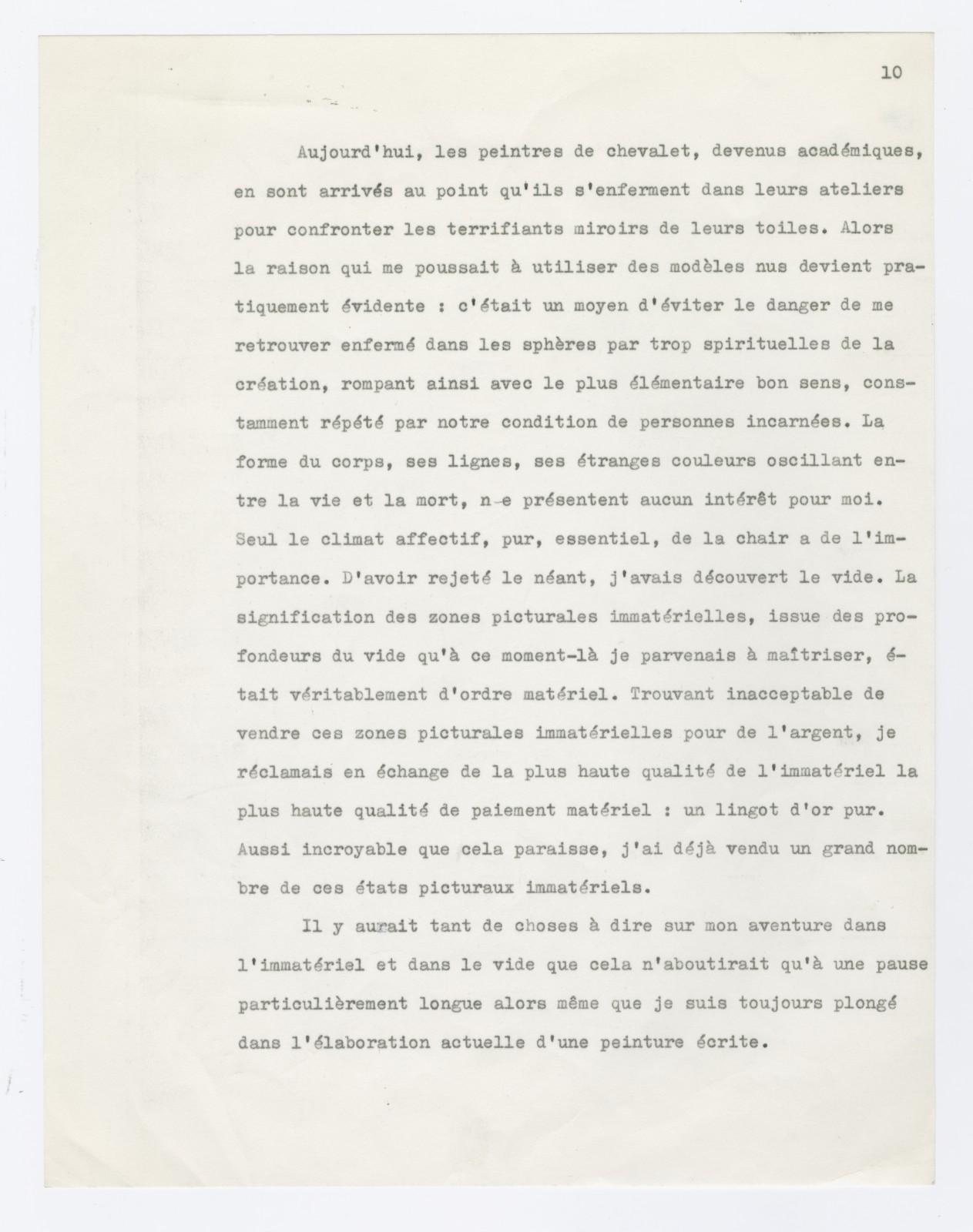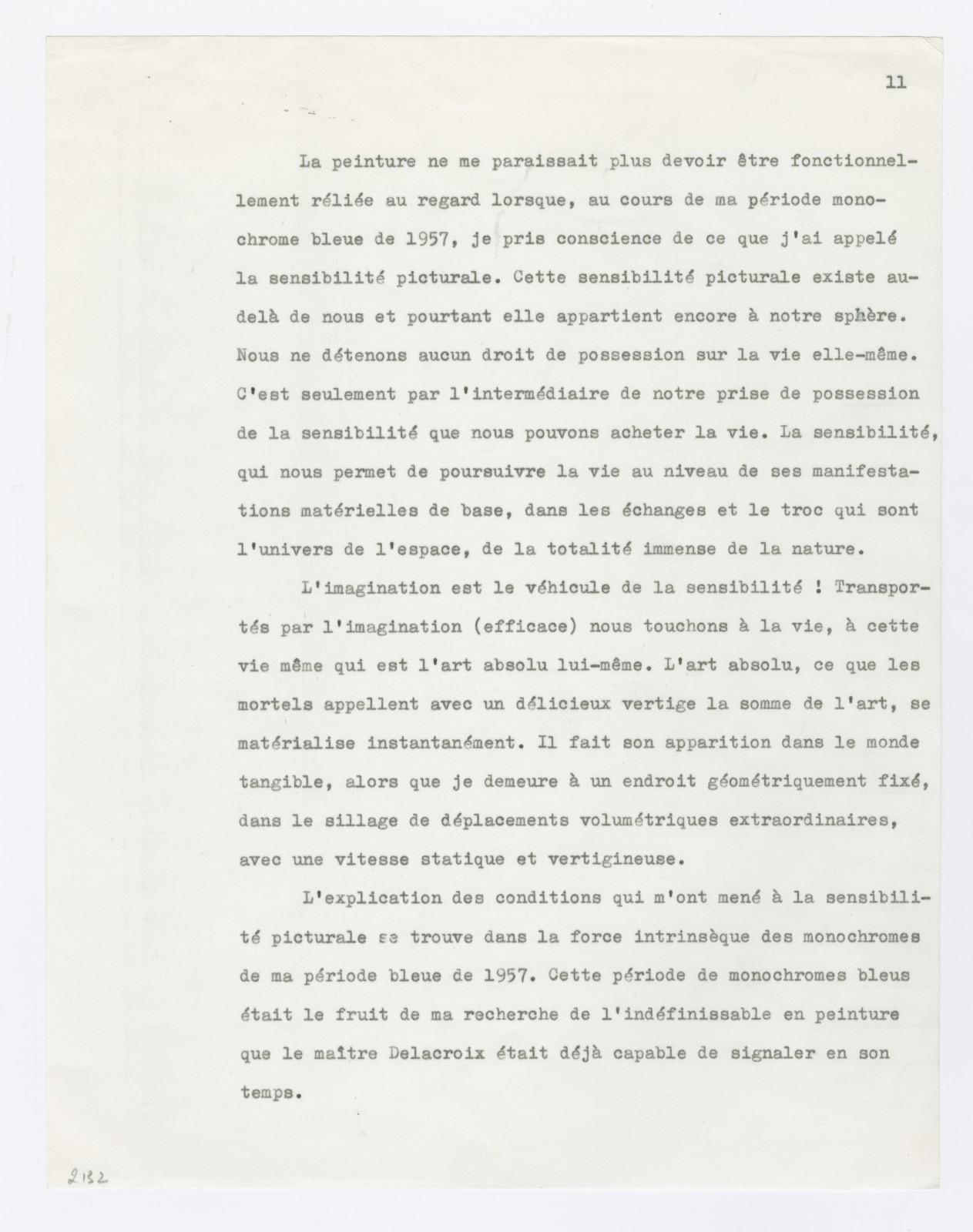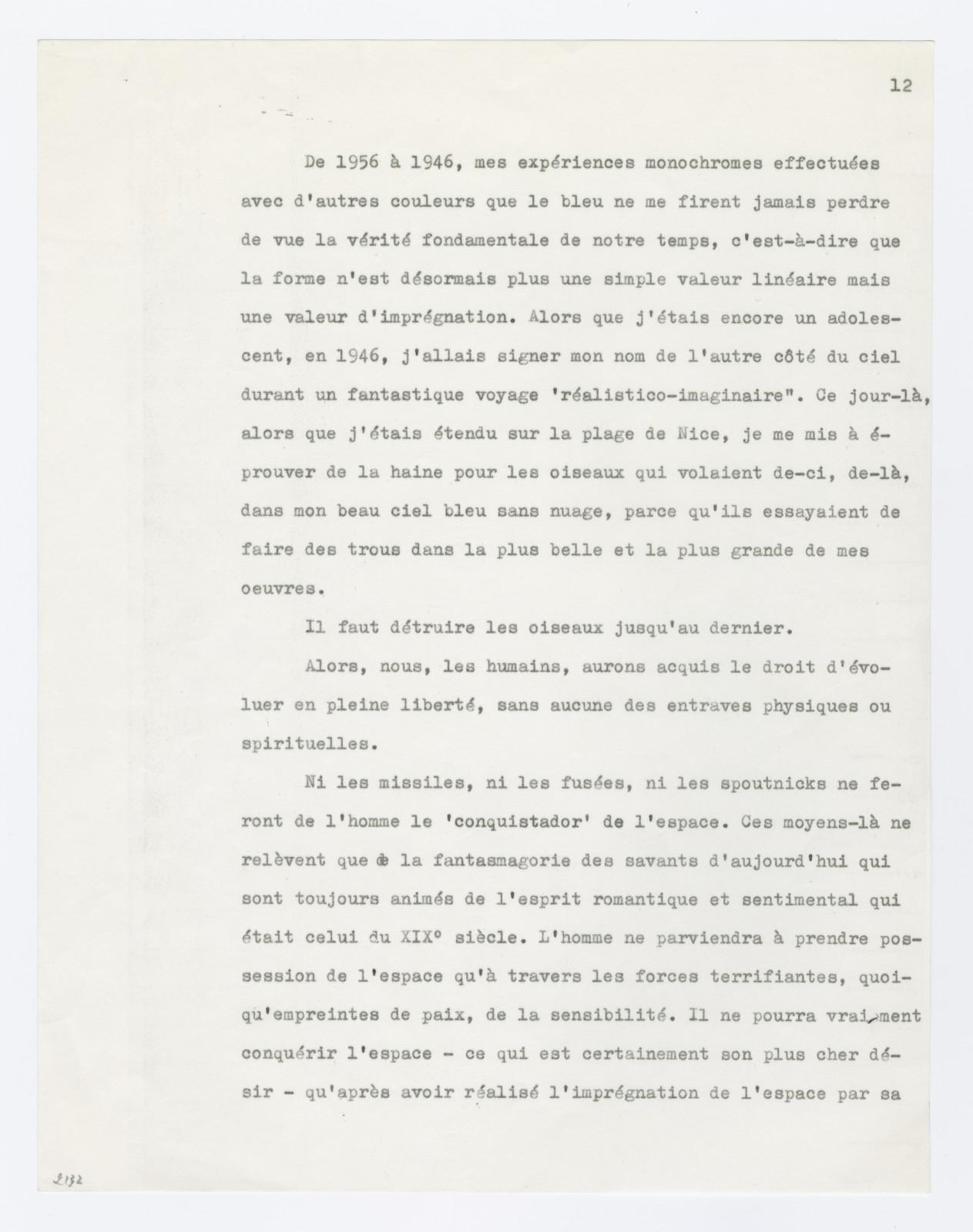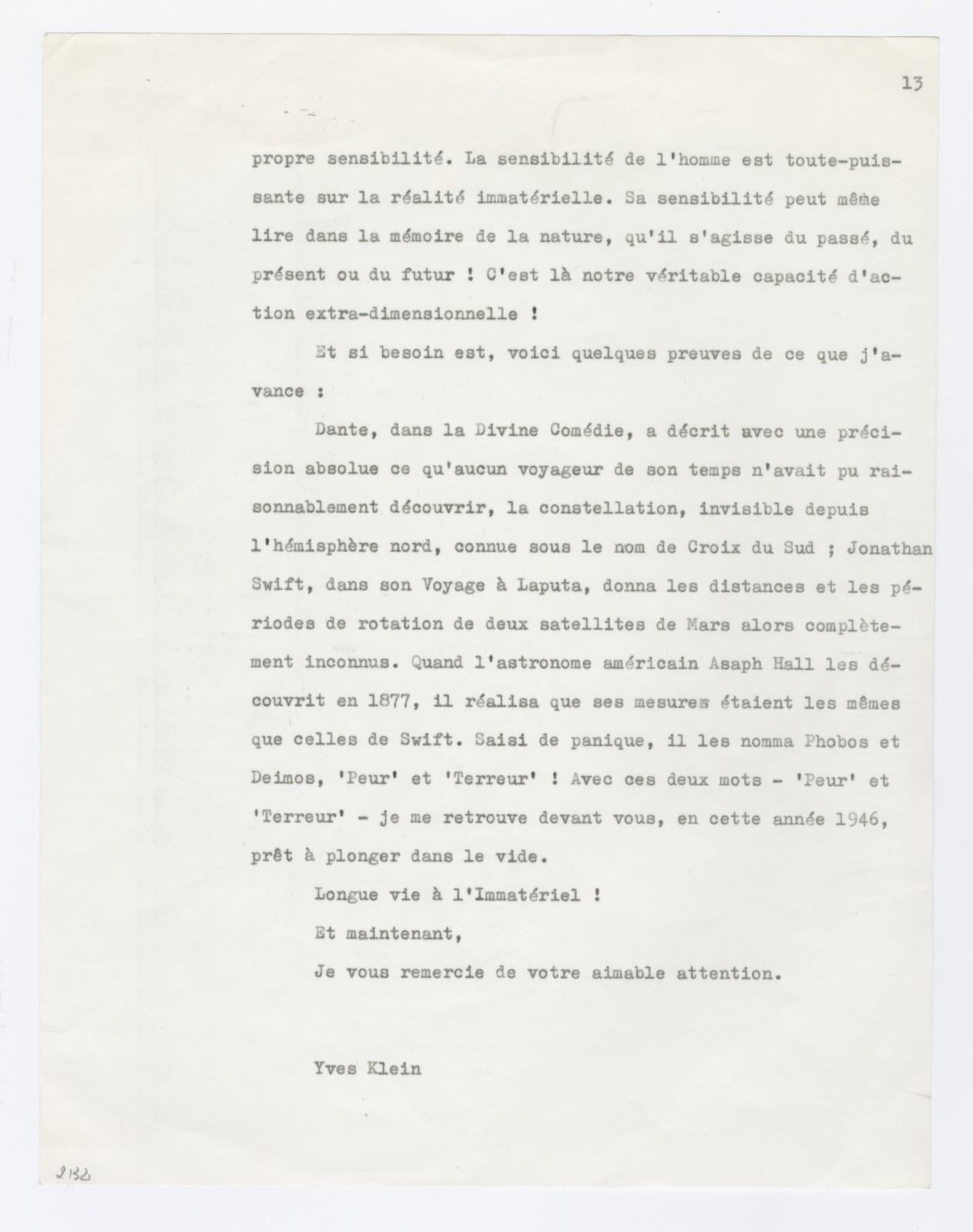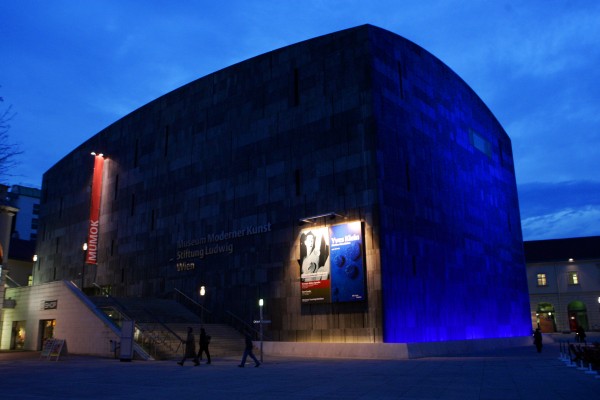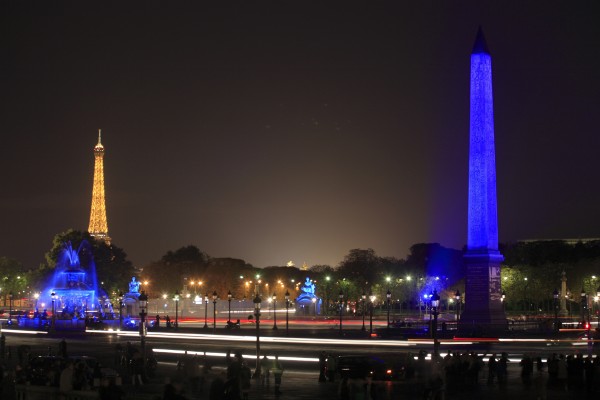Due to the fact that I have painted monochromes for fifteen years ...
Due to the fact that I have created pictorial immaterial states ...
Due to the fact that I have manipulated the forces of the void ...
Due to the fact that I have sculptured in fire and in water and have painted through fire, and through water ...
Due to the fact that I have painted with living brushes – in other words, the nude body of live models smothered in paint. These living brushes are under the constant direction of my commands, such as a little to the right; over to the left now; to the right again, etc. By maintaining myself at a definite and obligato- ry distance from the painting, I am able to resolve the problem of detachment ...
Due to the fact that I have invented the architecture and the urbanism of air – of course, this new conception transcends the traditional meaning of the terms, architecture and urbanism – my original goal being an attempt to reconstruct the legend of the lost Eden. This project has been directed toward the habitable surface of the Earth by the climatization of the great geographi- cal expanses through an absolute control over the thermic and atmospheric situations in their relation to our morphological and psychic conditions ...
Due to the fact that I have proposed a new conception of mu- sic with my monotone-silence-symphony ...
Due to the fact that I have also precipitated a theater of the void, among countless other adventures ...
I would never have believed fifteen years ago at the time of my earliest efforts that I would feel so suddenly the responsibil- ity to explain myself – to satisfy your desire to know the whys and the wherefores of all that has occurred and the still more dangerous whys and wherefores for me, in other words – the in- fluence of my art on the young generation of artists throughout the world today.
It disturbs me to hear that a certain number of them think that I represent a danger to the future of art – that I am one of those disastrous and nefarious products of our era who must be crushed and destroyed completely before the propagation of the progress of evil. I am sorry to have to reveal to them that this was not my intention; and to have to declaim with pleasure to those who evince a faith in the multiplicity of new possibilities in the path that I prescribe – Careful! Nothing has crystallized as yet; and whatever will happen after this, I cannot say. I can only say that I am not anymore afraid today than I was yesterday fac- ing the souvenir of the future.
An artist always feels a little uneasy when called upon to speak of his own works. They should speak for themselves, par- ticularly if they are valid works.
Therefore, what can I do? Stop now?
No, what I call the undefinable pictorial sensitivity absolute- ly forbids this very personal solution.
So ...
I think of those words that I was inspired to write one eve- ning. Wouldn’t the future artist be he who expresses through silence, but eternally, an immense painting lacking any sense of dimension?
The gallery-goers – always the same, just as the others – would carry this immense painting in their remembrance (a remem- brance which does not derive at an from the past but alone is cognizant of the possibility of increasing infinitely the incom- mensurable within the scope of the undefinable sensitivity of man). It is always necessary to create and recreate in a constant physical fluidity in order to receive the grace which permits the positive creativity of the void.
Just as I created a monotone-silence-symphony in 1947, com- posed in two parts – one broad continuous sound followed by an equally broad and extended silence, endowed with a limit- less dimension – in the same way, I shall attempt to put before you a written painting of the short history of my art, to be fol- lowed naturally at the end of my expose by a pure and affective silence.
My expose will close with the creation of a compelling a pos- teriori silence whose existence in our communal space, which is, after all, the space of a single being, is immune to the destruc- tive qualities of physical noise.
Much depends upon the success of my written painting in its initial technical and audible phase. Only then will the extraor- dinary a posteriori silence, in the midst of noise as well as in the cell of physical silence, generate a new and unique zone of pic- torial immaterial sensitivity.
Having reached this point today in time and knowledge, I propose to gird my loins, then back-step retrospectively along the diving board of my evolution. In the manner of an Olympic diver in the most classic technique of sport, I shall prepare for my leap into the future of today by moving backward prudent- ly, constantly keeping in sight the edge consciously attained today – the immaterialization of art.
What is the purpose of this retrospective journey in time ? Simply, neither do I want you nor myself, even for an instant, to fall into the grip of that phenomenon of sentimental and land- scaped dreams which would be provoked by an abrupt landing in the past. The latter is precisely the psychological past, the anti-space, which I have been leaving behind in my adventures of the last fifteen years.
At present, I am enthusiastically interested in the corny. I have the feeling that there exists in the very essence of bad taste a force capable of creating something far beyond what is traditionally termed art. I want to play with human sentimen- tality and morbidness in a cold and ferocious manner. Only very recently I have become a sort of undertaker (oddly enough, I am using the very terms of my enemies). Some of my latest works have been tombs and coffins. Within the same span of time, I have succeeded in painting with fire, using very powerful and searing gas flames, some ten to twelve feet in height, to lick the surface of a painting in order to record the spontaneous trace of fire.
In sum, my goal is twofold: first of all, to register the trace of human sentimentality in present-day civilization; secondly, to register the trace of fire which has engendered this very same civilization. And this because the void has always been my con- stant preoccupation; and I hold that in the heart of the void as well as in the heart of man, fires are burning.
All facts that are contradictory are genuine principles of uni- versal explanation. Fire is truly one of these genuine principles that are essentially self-contradictory, being at the same time mildness and torture in the heart and origin of our civilization. What provokes my search for the trace of sentimentality through the fabrication of super-graves and super-coffins, what provokes my search for the trace of fire, why should I search for the Trace itself?
Because every work of creation, regardless of its cosmic order, is the representation of a pure phenomenology – All that is phe- nomena manifests itself. This manifestation is always distinct from form and is the essence of the immediate, the trace of the Immediate.
A few months ago, for example, I felt the urge to register the signs of atmospheric behavior by recording on a canvas the in- stantaneous traces of spring showers, of south winds, and of lightning (Needless to say, the last-mentioned ended in a catas- trophe). For instance, a trip from Paris to Nice might have been a waste of time had I not spent it profitably by recording the wind. I placed a canvas, freshly coated with paint, upon the roof of my white Citroen. As I zoomed down Route Nationale 7 at the speed of 100 kilometers an hour, the heat, the cold, the light, the wind, and the rain all combined to age my canvas prematurely. At least thirty to forty years were condensed into one day. The only annoying thing about this project is that I have to travel with my painting all the time.
My atmospheric imprints of a few months ago had been pre- luded a year ago by vegetal imprints. After all, my purpose is to extract and conclude the trace of the immediate from any inci- dence of natural objects – human, animal, vegetable, or atmo- spheric circumstances.
I would like now, with your permission and attention, to divulge to you possibly the most important and certainly the most secret phase of my art. I don’t know whether you will be- lieve it or not, it’s cannibalism. After all, wouldn’t it be better to be eaten than to be bombed? I can hardly document this idea that has been tormenting me for some years, so I will leave it up to you to make your own conclusions on what I think will be the future of art.
Taking another step backward along the lines of my evolu- tion, we arrive two years ago at the moment when I devised painting with living brushes.
The purpose of this was to attain a definite and constant dis- tance between myself and the painting during the moment of creation.
Many art critics claimed that via this method of painting I was in fact merely reenacting the technique of what has been called action painting. I would like now to make it clear that this endeav- or is opposed to action painting in that I am actually completely detached from the physical work during its creation.
Just to cite one example fostered by the misrepresentation of anthropometry by my coverage in the international press – a group of Japanese painters eagerly applied this method in their own very different manner. These painters in fact transformed themselves into living brushes. By drowning themselves in col- or and then rolling on their canvases, they became ultra-action- painters! Personally, never would I attempt to smear paint over my own body and become a living brush; but on the contrary, I would rather put on my tuxedo and wear white gloves. I would not even think of dirtying my hands with paint. Detached and distant, the work of art must complete itself before my eyes and under my command. Thus, as soon as the work is real- ized, I stand there – present at the ceremony, spotless, calm, re- laxed, worthy of it, and ready to receive it as it is born into the tangible world.
Whatever directed me towards anthropometry? The answer can be found in my work during the years 1956 to 1957, when I was taking part in the adventure of creating the pictorial im- material sensitivity. I had just removed from my studio all my former works. The result – an empty studio. My only physical action was to remain in my empty studio, and the creation of my pictorial immaterial states proceeded marvelously. How- ever, little by little, I became mistrustful of myself: but never of the immaterial. I therefore hired models, as other painters do. But unlike the others, I merely wanted to work in their com- pany rather than have them pose for me. I had been spending too much time alone in the empty studio; I no longer wanted to remain alone with the marvelous blue void that was budding. Though seemingly strange, remember that I was aware of not having that vertigo experienced by all my predecessors facing the absolute void which forcibly is the real pictorial space. But how long could my security in this awareness endure?
Years ago, the artist went directly to his subject, worked out- doorsinthecountry,hadhisfeetfirmlyplantedontheground–it was healthy.
Today, the academicized easel-painters have reached the point of shutting themselves in their studios, confronting the terri- fying mirrors of their canvases. Now the reason for my use of nude models becomes quite evident: it was a way of preventing the danger of secluding myself in the overly spiritual spheres of creation, thus rupturing with the most basic common sense, repeatedly affirmed by our incarnate condition. The shape of the body, its lines, its strange colors hovering between life and death, hold no interest for me. Only the essential, pure affective climate of the flesh is valid.
I was introduced to the void by the rebuffed nothingness. The mining of the pictorial immaterial zones, extracted from the depth of the void which I possessed by that time, was of a very material nature. Finding it unacceptable to sell these immate- rial zones for money, I demanded in exchange for the highest quality of the immaterial the highest quality of material pay- ment – a bar of pure gold. Incredible as it may seem, I have actu- ally sold a number of these pictorial immaterial states.
So much could be said about my adventure in the immate- rial and the void that the result would be an overly extended pause while still immersed in the present erection of my writ- ten painting.
Painting no longer appeared to me to be functionally related to the eye when in my blue monochrome period of 1957 I be- came acquainted with what I have termed the pictorial sensi- tivity. This pictorial sensitivity exists beyond our being and yet belongs in our sphere. We hold no right of possession over life itself. It is only by the means of our possession of sensitivity that we are able to buy life. Sensitivity, which enables us to purchase life at its basic material levels, in the barter price of the universe of space, of the grand totality of nature.
Imagination is the vehicle of sensitivity! Transported by (effective) imagination we attain life, that very life which is ab- solute art itself. Absolute art, what mortal men call with a sensa- tion of vertigo the summum of art, materializes instantaneously; It makes its appearance in the tangible world, myself remaining at a fixed geometric point, in the track of such volumetric dis- placements with a static and vertiginous speed.
The answer to the question of how I was introduced to picto- rial sensitivity may be found in the intrinsic force of the mono- chromes of my blue period of 1957. This period of blue mono- chromes was the fruit of my quest for the undefinable in paint- ing which the master Delacroix could already intimate.
From 1956 to 1946, my monochromes experiences in various other colors but blue never let me forget the fundamental truth of our age – that is to say, form no longer is a linear value but rather a value of impregnation.
Just an adolescent in 1946, I went to sign my name on the underside of the sky during a fantastic realistico-imaginary journey. That day, as I lay on the beach at Nice, I began to hate the birds which occasionally flew in my pure, unclouded blue sky, because they tried to bore holes in my greatest and more beautiful work.
Birds must be eliminated.
Thus, we humans shall possess the right to levitate in an ef- fective and total physical and spiritual freedom.
Neither missiles nor rockets nor sputniks will render man the conquistador of space. These means are only dream world of today’s scientists who still live in the romantic and sentimental spirit of the xIx century.
Man will only arrive at inhabiting space through the terri- fying though pacifying force of sensitivity. The real conquest of space so much desired by him will only result from the im- pregnation of man’s sensitivity in space. Man’s sensitivity is om- nipotent in the immaterial reality. His sensitivity can even see into the memory of the nature of the past, of the present, and of the future!
It is our effective extradimensional capacity for action!
If proofs, precedents or predecessors are needed, let me then cite: Dante, in the Divine Comedy, described with absolute preci- sion what no traveler of his time could possibly have discovered, the invisible constellation of the Northern Hemisphere known as the Southern Cross; Jonathan Swift, in his Voyage to Laputa, gave the distances and periods of rotation of two satellites of Mars though they were unknown at the time.
When the American astronomer Asaph Hall, discovered them in 1877, he realized that his measurements were the same as those of Swift. Seized by panic, he named them Phobos and Deimos – Fear and Terror! With these two words – Fear and Ter- ror – I find myself in front of you in the year 1946, ready to dive into the void.
Long Live the Immaterial!
And now,
I thank you so much for your kind attention.
Yves Klein
Due to the fact that I have created pictorial immaterial states ...
Due to the fact that I have manipulated the forces of the void ...
Due to the fact that I have sculptured in fire and in water and have painted through fire, and through water ...
Due to the fact that I have painted with living brushes – in other words, the nude body of live models smothered in paint. These living brushes are under the constant direction of my commands, such as a little to the right; over to the left now; to the right again, etc. By maintaining myself at a definite and obligato- ry distance from the painting, I am able to resolve the problem of detachment ...
Due to the fact that I have invented the architecture and the urbanism of air – of course, this new conception transcends the traditional meaning of the terms, architecture and urbanism – my original goal being an attempt to reconstruct the legend of the lost Eden. This project has been directed toward the habitable surface of the Earth by the climatization of the great geographi- cal expanses through an absolute control over the thermic and atmospheric situations in their relation to our morphological and psychic conditions ...
Due to the fact that I have proposed a new conception of mu- sic with my monotone-silence-symphony ...
Due to the fact that I have also precipitated a theater of the void, among countless other adventures ...
I would never have believed fifteen years ago at the time of my earliest efforts that I would feel so suddenly the responsibil- ity to explain myself – to satisfy your desire to know the whys and the wherefores of all that has occurred and the still more dangerous whys and wherefores for me, in other words – the in- fluence of my art on the young generation of artists throughout the world today.
It disturbs me to hear that a certain number of them think that I represent a danger to the future of art – that I am one of those disastrous and nefarious products of our era who must be crushed and destroyed completely before the propagation of the progress of evil. I am sorry to have to reveal to them that this was not my intention; and to have to declaim with pleasure to those who evince a faith in the multiplicity of new possibilities in the path that I prescribe – Careful! Nothing has crystallized as yet; and whatever will happen after this, I cannot say. I can only say that I am not anymore afraid today than I was yesterday fac- ing the souvenir of the future.
An artist always feels a little uneasy when called upon to speak of his own works. They should speak for themselves, par- ticularly if they are valid works.
Therefore, what can I do? Stop now?
No, what I call the undefinable pictorial sensitivity absolute- ly forbids this very personal solution.
So ...
I think of those words that I was inspired to write one eve- ning. Wouldn’t the future artist be he who expresses through silence, but eternally, an immense painting lacking any sense of dimension?
The gallery-goers – always the same, just as the others – would carry this immense painting in their remembrance (a remem- brance which does not derive at an from the past but alone is cognizant of the possibility of increasing infinitely the incom- mensurable within the scope of the undefinable sensitivity of man). It is always necessary to create and recreate in a constant physical fluidity in order to receive the grace which permits the positive creativity of the void.
Just as I created a monotone-silence-symphony in 1947, com- posed in two parts – one broad continuous sound followed by an equally broad and extended silence, endowed with a limit- less dimension – in the same way, I shall attempt to put before you a written painting of the short history of my art, to be fol- lowed naturally at the end of my expose by a pure and affective silence.
My expose will close with the creation of a compelling a pos- teriori silence whose existence in our communal space, which is, after all, the space of a single being, is immune to the destruc- tive qualities of physical noise.
Much depends upon the success of my written painting in its initial technical and audible phase. Only then will the extraor- dinary a posteriori silence, in the midst of noise as well as in the cell of physical silence, generate a new and unique zone of pic- torial immaterial sensitivity.
Having reached this point today in time and knowledge, I propose to gird my loins, then back-step retrospectively along the diving board of my evolution. In the manner of an Olympic diver in the most classic technique of sport, I shall prepare for my leap into the future of today by moving backward prudent- ly, constantly keeping in sight the edge consciously attained today – the immaterialization of art.
What is the purpose of this retrospective journey in time ? Simply, neither do I want you nor myself, even for an instant, to fall into the grip of that phenomenon of sentimental and land- scaped dreams which would be provoked by an abrupt landing in the past. The latter is precisely the psychological past, the anti-space, which I have been leaving behind in my adventures of the last fifteen years.
At present, I am enthusiastically interested in the corny. I have the feeling that there exists in the very essence of bad taste a force capable of creating something far beyond what is traditionally termed art. I want to play with human sentimen- tality and morbidness in a cold and ferocious manner. Only very recently I have become a sort of undertaker (oddly enough, I am using the very terms of my enemies). Some of my latest works have been tombs and coffins. Within the same span of time, I have succeeded in painting with fire, using very powerful and searing gas flames, some ten to twelve feet in height, to lick the surface of a painting in order to record the spontaneous trace of fire.
In sum, my goal is twofold: first of all, to register the trace of human sentimentality in present-day civilization; secondly, to register the trace of fire which has engendered this very same civilization. And this because the void has always been my con- stant preoccupation; and I hold that in the heart of the void as well as in the heart of man, fires are burning.
All facts that are contradictory are genuine principles of uni- versal explanation. Fire is truly one of these genuine principles that are essentially self-contradictory, being at the same time mildness and torture in the heart and origin of our civilization. What provokes my search for the trace of sentimentality through the fabrication of super-graves and super-coffins, what provokes my search for the trace of fire, why should I search for the Trace itself?
Because every work of creation, regardless of its cosmic order, is the representation of a pure phenomenology – All that is phe- nomena manifests itself. This manifestation is always distinct from form and is the essence of the immediate, the trace of the Immediate.
A few months ago, for example, I felt the urge to register the signs of atmospheric behavior by recording on a canvas the in- stantaneous traces of spring showers, of south winds, and of lightning (Needless to say, the last-mentioned ended in a catas- trophe). For instance, a trip from Paris to Nice might have been a waste of time had I not spent it profitably by recording the wind. I placed a canvas, freshly coated with paint, upon the roof of my white Citroen. As I zoomed down Route Nationale 7 at the speed of 100 kilometers an hour, the heat, the cold, the light, the wind, and the rain all combined to age my canvas prematurely. At least thirty to forty years were condensed into one day. The only annoying thing about this project is that I have to travel with my painting all the time.
My atmospheric imprints of a few months ago had been pre- luded a year ago by vegetal imprints. After all, my purpose is to extract and conclude the trace of the immediate from any inci- dence of natural objects – human, animal, vegetable, or atmo- spheric circumstances.
I would like now, with your permission and attention, to divulge to you possibly the most important and certainly the most secret phase of my art. I don’t know whether you will be- lieve it or not, it’s cannibalism. After all, wouldn’t it be better to be eaten than to be bombed? I can hardly document this idea that has been tormenting me for some years, so I will leave it up to you to make your own conclusions on what I think will be the future of art.
Taking another step backward along the lines of my evolu- tion, we arrive two years ago at the moment when I devised painting with living brushes.
The purpose of this was to attain a definite and constant dis- tance between myself and the painting during the moment of creation.
Many art critics claimed that via this method of painting I was in fact merely reenacting the technique of what has been called action painting. I would like now to make it clear that this endeav- or is opposed to action painting in that I am actually completely detached from the physical work during its creation.
Just to cite one example fostered by the misrepresentation of anthropometry by my coverage in the international press – a group of Japanese painters eagerly applied this method in their own very different manner. These painters in fact transformed themselves into living brushes. By drowning themselves in col- or and then rolling on their canvases, they became ultra-action- painters! Personally, never would I attempt to smear paint over my own body and become a living brush; but on the contrary, I would rather put on my tuxedo and wear white gloves. I would not even think of dirtying my hands with paint. Detached and distant, the work of art must complete itself before my eyes and under my command. Thus, as soon as the work is real- ized, I stand there – present at the ceremony, spotless, calm, re- laxed, worthy of it, and ready to receive it as it is born into the tangible world.
Whatever directed me towards anthropometry? The answer can be found in my work during the years 1956 to 1957, when I was taking part in the adventure of creating the pictorial im- material sensitivity. I had just removed from my studio all my former works. The result – an empty studio. My only physical action was to remain in my empty studio, and the creation of my pictorial immaterial states proceeded marvelously. How- ever, little by little, I became mistrustful of myself: but never of the immaterial. I therefore hired models, as other painters do. But unlike the others, I merely wanted to work in their com- pany rather than have them pose for me. I had been spending too much time alone in the empty studio; I no longer wanted to remain alone with the marvelous blue void that was budding. Though seemingly strange, remember that I was aware of not having that vertigo experienced by all my predecessors facing the absolute void which forcibly is the real pictorial space. But how long could my security in this awareness endure?
Years ago, the artist went directly to his subject, worked out- doorsinthecountry,hadhisfeetfirmlyplantedontheground–it was healthy.
Today, the academicized easel-painters have reached the point of shutting themselves in their studios, confronting the terri- fying mirrors of their canvases. Now the reason for my use of nude models becomes quite evident: it was a way of preventing the danger of secluding myself in the overly spiritual spheres of creation, thus rupturing with the most basic common sense, repeatedly affirmed by our incarnate condition. The shape of the body, its lines, its strange colors hovering between life and death, hold no interest for me. Only the essential, pure affective climate of the flesh is valid.
I was introduced to the void by the rebuffed nothingness. The mining of the pictorial immaterial zones, extracted from the depth of the void which I possessed by that time, was of a very material nature. Finding it unacceptable to sell these immate- rial zones for money, I demanded in exchange for the highest quality of the immaterial the highest quality of material pay- ment – a bar of pure gold. Incredible as it may seem, I have actu- ally sold a number of these pictorial immaterial states.
So much could be said about my adventure in the immate- rial and the void that the result would be an overly extended pause while still immersed in the present erection of my writ- ten painting.
Painting no longer appeared to me to be functionally related to the eye when in my blue monochrome period of 1957 I be- came acquainted with what I have termed the pictorial sensi- tivity. This pictorial sensitivity exists beyond our being and yet belongs in our sphere. We hold no right of possession over life itself. It is only by the means of our possession of sensitivity that we are able to buy life. Sensitivity, which enables us to purchase life at its basic material levels, in the barter price of the universe of space, of the grand totality of nature.
Imagination is the vehicle of sensitivity! Transported by (effective) imagination we attain life, that very life which is ab- solute art itself. Absolute art, what mortal men call with a sensa- tion of vertigo the summum of art, materializes instantaneously; It makes its appearance in the tangible world, myself remaining at a fixed geometric point, in the track of such volumetric dis- placements with a static and vertiginous speed.
The answer to the question of how I was introduced to picto- rial sensitivity may be found in the intrinsic force of the mono- chromes of my blue period of 1957. This period of blue mono- chromes was the fruit of my quest for the undefinable in paint- ing which the master Delacroix could already intimate.
From 1956 to 1946, my monochromes experiences in various other colors but blue never let me forget the fundamental truth of our age – that is to say, form no longer is a linear value but rather a value of impregnation.
Just an adolescent in 1946, I went to sign my name on the underside of the sky during a fantastic realistico-imaginary journey. That day, as I lay on the beach at Nice, I began to hate the birds which occasionally flew in my pure, unclouded blue sky, because they tried to bore holes in my greatest and more beautiful work.
Birds must be eliminated.
Thus, we humans shall possess the right to levitate in an ef- fective and total physical and spiritual freedom.
Neither missiles nor rockets nor sputniks will render man the conquistador of space. These means are only dream world of today’s scientists who still live in the romantic and sentimental spirit of the xIx century.
Man will only arrive at inhabiting space through the terri- fying though pacifying force of sensitivity. The real conquest of space so much desired by him will only result from the im- pregnation of man’s sensitivity in space. Man’s sensitivity is om- nipotent in the immaterial reality. His sensitivity can even see into the memory of the nature of the past, of the present, and of the future!
It is our effective extradimensional capacity for action!
If proofs, precedents or predecessors are needed, let me then cite: Dante, in the Divine Comedy, described with absolute preci- sion what no traveler of his time could possibly have discovered, the invisible constellation of the Northern Hemisphere known as the Southern Cross; Jonathan Swift, in his Voyage to Laputa, gave the distances and periods of rotation of two satellites of Mars though they were unknown at the time.
When the American astronomer Asaph Hall, discovered them in 1877, he realized that his measurements were the same as those of Swift. Seized by panic, he named them Phobos and Deimos – Fear and Terror! With these two words – Fear and Ter- ror – I find myself in front of you in the year 1946, ready to dive into the void.
Long Live the Immaterial!
And now,
I thank you so much for your kind attention.
Yves Klein
| Technical | Tapuscrit sur papier |
